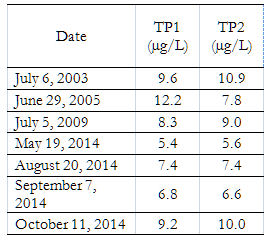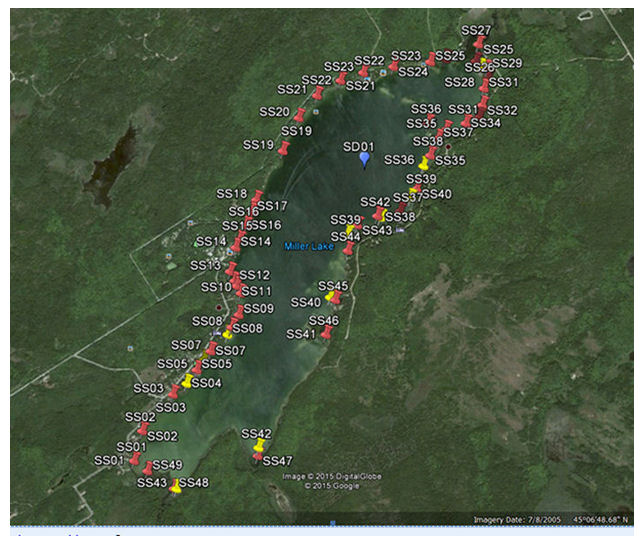MNRF Monitors Miller Lake
July 2016
Scientists from the Ministry of Natural Resources and Forestry will be conducting tests on Miller Lake this summer.
They will collect information on fish species, take water samples, and be checking for invasive species. Tests will last from 5 - 10 days.
If you're on the lake while it's being monitored and see MNRF buoys, please don't lift the nets or buoys, and avoid recreational activities or anchoring between and around the buoys. The point is to not disrupt the test results. All MNRF nets are clearly marked with orange buoys bearing the Ontario logo. Nets are checked and moved to a new location every day.
Since the biological data that will be collected may influence stocking of the lake in future, it's important that the testing be as accurate as possible.
Miller Lake Water Quality Report 2015
from Dave Dolson, Water Steward
July 2015
A healthy lake benefits everyone, and protects property values. We should all do what we can to have a natural shore-line, avoid lawn fertilizer and keep our septic systems well-maintained.
Topics:
- Water sampling for Lake Partner Program
- Temperature and clarity readings (Secchi disk)
- E-Coli Testing
- Guide to Eating Ontario Fish
Lake Partner Program
Ontario Ministry of Environment, in partnership with FOCA: http://foca.on.ca/lake-partner-program-overview/
- Water samples taken 6 times per year (May thru September)
- Lab testing is provided (by Dorset Environmental Science Centre) for total phosphorus and calcium
- Too much phosphorus can lead to algal blooms, which can be toxic
- Too little calcium impairs growth of plankton, which are at the base of the food chain
Here are the data from over 10 years:

The most recent reading is trending upwards. If the trend continues, we will be seeing algal blooms. Levels near 20 µg/L virtually guarantee algal blooms will occur.
The phosphorus is probably from man-made sources. Please take care to avoid fertilizer run-off from your lawns; use low-phosphate detergent;
Keep septic system in good repair and health; avoid bleach, micro-beads and antibacterial soap.
Temperature and Clarity
This year the secchi depth readings are in the same range as last year. July 11 reading was 2.0m.
E-Coli Testing in 2014
We paid for lab testing by ALS in Waterloo. Results posted on Miller Lake web site: http://millerlake.org/lake/e-coli2014.html
All levels were well below health Canada's swimming advisory of 200 per 100mL. 11 of the sites registered at 3 units or lower; one site at 46 units. Other notes:
- Plans for E-Coli testing for 2015 - in early August.
- We should also test for coliform, as an indicator of disease-causing organisms.
- Testing same 12 sites (for consistency) for e-coli and coliform will cost $504+HST
- (Testing only e-coli would be $336 + HST
Eating Miller Lake Fish

This year Miller lake is listed in the Guide to Eating Ontario Fish (available online http://www.ontario.ca/environment-and-energy/guide-eating-ontario-fish )
The reasons for restriction are mercury (1) and PCBs (2). - Example: Walleye 16" long may be consumed 16 times per month by the general population and 4 times per month by children and women of child-bearing age.
Contact
Please contact me with questions:
Dave Dolson
ddolson@golden.net
(519) 404-3956
Markers indicate the 47 locations that used to be sampled yearly.
Sites Sampled in 2014:
SS01 / SS06 / SS11 / SS15 / SS18 / SS22 / SS25 / SS27 / SS32 / SS37 / SS41 / SS45

Self-Reporting of Break-ins
January 2015
Because cottages are seasonal and often isolated, they have a higher ratio of break-ins, especially during the winter. Typically, when the vandalism or theft is discovered, O.P.P. are called or the owner has to report to the local police detachment.

Since these crimes generally involve minor theft and damage, the O.P.P. have set up a self-reporting page on their web site. Under certain criteria, you can submit your own report. Then, the police will call you for a follow-up and a potential visit, if required.
The criteria is for theft or vandalism under $5000, with no personal injuries or suspects involved.
This saves resources and creates a database that tracks local crime. It saves resources by allowing police to schedule site visits in clusters rather than randomly. Since the crime is not in progress, there is no urgency to attend, especially when other emergency situations might be developing. The database will reveal patterns and methods that pin-point potential suspects in an area.
The police report is often necessary for insurance claims.
Admittedly, it is oddly satisfying having the police show up after you find your property, and privacy, has been 'violated'. There's a certain comfort in feeling that your pain is being taken seriously. There's also the satisfaction of thinking your tax money has been used to your advantage.
Well, to quote The Eagles, get over it. Fiscal restraint is the way of the future, and diminishing services are the result of it. This is a logical attempt by the O.P.P. to rein in some costs.
Here is the link for the 'Self Reporting' web page: